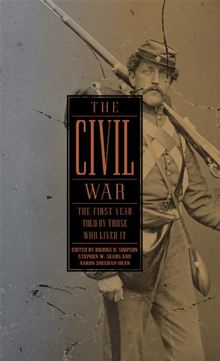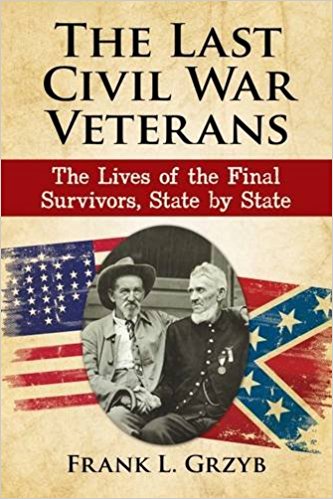The Civil War: The First Year As Told By Those Who Lived It edited by Brooks D. Simpson, Stephen W. Sears, and Aaron Sheehan-Dean. The Library of America, First Edition, 2011. Cloth, ISBN: 1598530887. $37.50.
 In his incisive 2005 anthology What Caused the Civil War?, Edward L. Ayers called on his fellow historians to challenge the simplicity and triumphalism of Americans’ “common sense” Civil War narrative. Ayers posited that the key to unlocking a more honest, complex story of the war was an appreciation of its “deep contingencies.” “All social life is ‘contingent,’ implicated and unpredictable,” he wrote, “because all parts of life depend on one another. What we think of as public and private, economic and political, religious and secular, and military and civilian are deeply connected…. An argument for deep contingency is based on the simple principle that the best explanation reckons with the most information” (135).
In his incisive 2005 anthology What Caused the Civil War?, Edward L. Ayers called on his fellow historians to challenge the simplicity and triumphalism of Americans’ “common sense” Civil War narrative. Ayers posited that the key to unlocking a more honest, complex story of the war was an appreciation of its “deep contingencies.” “All social life is ‘contingent,’ implicated and unpredictable,” he wrote, “because all parts of life depend on one another. What we think of as public and private, economic and political, religious and secular, and military and civilian are deeply connected…. An argument for deep contingency is based on the simple principle that the best explanation reckons with the most information” (135).
With the first of a four-volume series chronicling the Civil War from The Library of America, editors Brooks D. Simpson, Stephen W. Sears, and Aaron Sheehan-Dean have expertly selected, arranged, and introduced primary documents in a way that allows students to experience the “deep contingencies” of the war’s opening year. “By reading what people wrote as history unfolded before them,” they write in a succinct introduction, “we can gain a better appreciation for what people thought was at stake, and for what the war was all about” (xxi).
This handsome volume (illustrated with three colorful, endpaper maps by Earl McElfresh) begins with the Charleston Mercury’s November 1860 call for a secession convention and concludes with newly installed Secretary of War Edwin M. Stanton’s famous letter to Charles A. Dana (“This army has got to fight…”) in January 1862. Month by month, the editors take us through the secession winter, the Sumter crisis, the mobilization of the armies, the “death and confusion” of Bull Run and Ball’s Bluff, diplomatic dilemmas like the Trent affair, and the complexities of the contraband “problem.” The documents anthologized here compel students to consider each month of the war not as ticks on the timeline, but as individual historical moments animated by doubt, volatility, and human emotion.
The editors have carefully chosen and fully annotated a wide array of sources— including newspaper accounts, personal diary entries, private letters, public speeches, songs, common soldier letters and memoirs—drawn from “persons of every class and condition” (xix). We encounter Frederick Douglass, insisting in May 1861 that striking down slavery was “the simple way” to end the war; Chief John Ross, admonishing the Cherokee people to remain neutral; a Kentucky surgeon, describing for his father the “terrible sameness” of the dead at Belmont; and a young Emma Holmes, recording in her diary the rebel victory at Bull Run (333-335, 412-414, 594, 495-497). Only the voices of those on the northern homefront—most often represented by the prolific diarist George Templeton Strong or New York City newspaper editorials—are somewhat underrepresented here. Specialists will be quite familiar with these sources and their authors, who are the subject of concise biographical sketches in an appendix, but, as a result, this is a handy volume from which to build or enrich a lecture course.
Indeed, the strengths of this collection recommend it for use in the undergraduate classroom. Pairing individual “months” of this collection with two essays from the Ayers anthology, “Worrying About the Civil War” and “What Caused the Civil War,” as well as one of the standard survey texts, would make for a potentially exciting discussion of how historians craft master narratives and render judgments about the past, sifting through a cacophony of voices. Because the collection offers such keen insight into how diverse constituencies thought about the period’s major questions, instructors might also invite students to “represent” one of these groups (African Americans, white southern women, northern Republicans) in an interactive class dialogue based entirely on the attitudes and opinions of historical actors.
If nothing else, these sharp documents will immediately challenge students to resist the allure of inevitability and instead, in Ayers’ words, approach the Civil War “without a comforting story already in hand.” In the midst of a sesquicentennial commemoration in which the National Park Service sums up our nation’s “fiery trial” as the simple story of “620,000 dead, 4 million freed, and 1 nation saved,” we need more editorial projects like this one, worthy of the past and her many incongruities.
Brian Matthew Jordan is adjunct instructor of Civil War Era Studies at Gettysburg College and is finishing a book on the lives of Union veterans.
